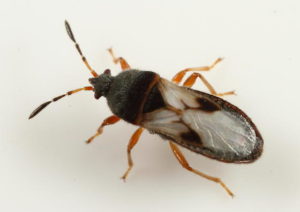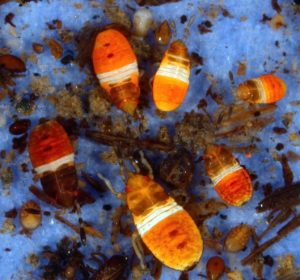According to the responses you entered, this is likely the pest you are dealing with. To confirm this, use the positive identification section.

Chinch bug adult. Photo by Graham Montgomery.
Scientific Names
Blissus leucopterus
Biology
Chinch bug adults overwinter in bunch grass. When temperatures reach 70° F they will move over into sorghum. Eggs are typically laid on the lower leaf sheaths, roots or in the ground near the plant. Chinch bugs suck plant juices from the stem, leaves and roots of the plant. Young plants are most susceptible. Multiple generations per year may occur. The complete life cycle takes about 40 days. Chinch bugs are most problematic in hot dry conditions.
Positive Identification

Juvenile chinch bugs. Photo by John Obermeyer, Purdue University.
Chinch bug adults have a black body color. Their legs are reddish yellow in color. The adults are most easily identified by the patterns on their wings. Wings are white with two black triangular veins on each side. Juveniles are an orange-yellowish color and then become redder as they develop. Older juveniles have a white band on their back. The oldest nymphs are black and gray in color.
Other Important Hosts
Wild bunch grasses or other small grains.
Scouting Tips
Check at least five random plants per field for chinch bugs. Examine the entire plant carefully and the surrounding soil to look for these insects.
Although we tried to include the most significant pests related to sorghum our tool cannot help you identify every insect found on sorghum. This tool is built to inform you of the most common and significant pests of sorghum in Texas. If the insect you are dealing with does not match the description above then talk to your extension agent or visit this page to look at all the different important potential pest associated with each part and growth stage of sorghum. For management information of a specific pest talk to your local extension office.